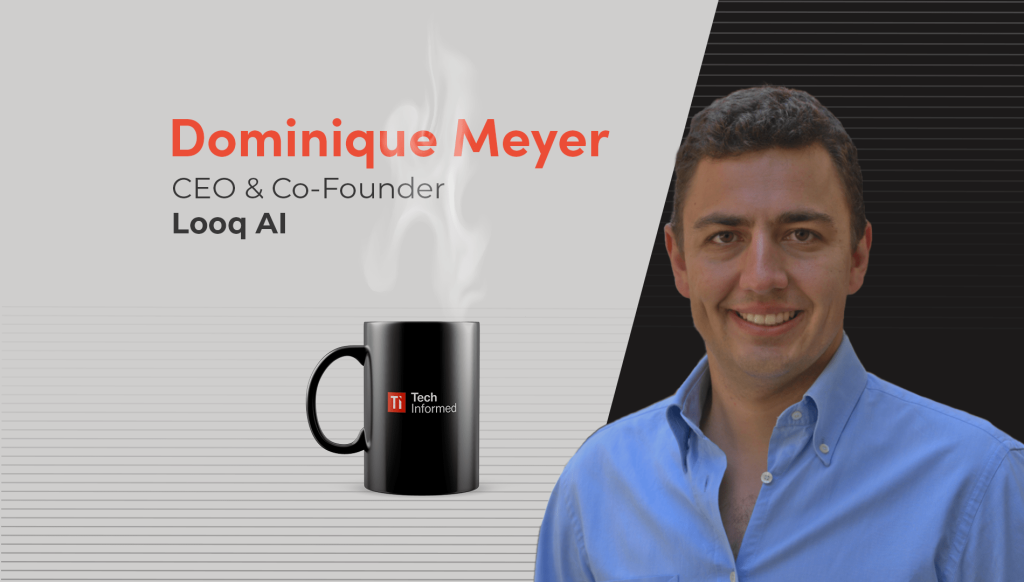

A coffee with….Dominique Meyer, CEO and cofounder, Looq AI
Swiss-born Dominique Meyer moved to the US, aged 17, to study Physics at the University of California in San Diego, followed by a PHD and an MBA. He cofounded his start up Looq AI from…
Swiss-born Dominique Meyer moved to the US, aged 17, to study Physics at the University of California in San Diego, followed by a PHD and an MBA.
He cofounded his start up Looq AI from his garage in 2021 with his former roomie, Shreyas Niradi, a computer vision scientist.
Informed by his early work on self-driving vehicles, Meyer’s vision was to build an AI camera system capable of digitising the built environment.
The resulting product, the Looq platform, is an AI-enabled digital twin platform designed to create precise digital representations of physical infrastructure to facilitate efficient mapping and management of assets.
Keen to test-run the product on applied use cases, Meyer used an early version on a construction site at his own university campus to scan for anomalies on piping, structures and wiring.
After receiving funding initially from friends and family, in 2023 Looq secured a $2.6m seed funding round from a VC, bringing its total raised to $3.75 million to date.
According to Meyer, some of the largest engineering and construction companies in the world now use Looq to help with the maintenance and health of critical infrastructure such as bridges, highways and power lines.
Meyer was also involved in the recovery efforts following the Mexico City Earthquake of 2017.
Can you explain your product in a nutshell?
We’re a hardware-enabled software company focused on digitising critical infrastructure. Our ‘Q’ camera system, about the size of a football, includes four cameras and a GPS, and attaches to a mobile phone for easy surveying.
Anyone—whether an intern, technician, engineer, or surveyor—can capture data for 3D reconstruction. The AI on the device automatically filters out people and vehicles for privacy, and once the data is uploaded to the cloud, our 3D AI application converts it into a model that works with most CAD systems. We’ve developed a faster, more accurate method than traditional photogrammetry or SLAM.
Can Looq monitor the health of critical infrastructure like bridges in real time?
While not real-time in the strictest sense, our technology provides near-instant insights into asset conditions. Key to this is change detection—identifying new features like cracks, expanding gaps, or rust over 6 to 12 months. As we build our tech and industry standards evolve, we help accelerate the feedback loop, ensuring more timely and actionable data for infrastructure management.
How has Looq’s technology been pivotal in safeguarding critical infrastructure?
A notable example involved a construction company needing to verify whether a concrete slab poured over a 60,000 square ft area at a university was at the correct height.
An error of just three inches could have led to a month-long delay and cost hundreds of thousands of dollars. Using Looq’s data, the company quickly confirmed the measurements, impacting 40-50 people and ensuring the project’s profitability. It wasn’t life-threatening, but it was the difference between making or losing money on the project.
We’ve also helped structural engineering and asset management firms like EXO gather detailed data about power lines and structures, allowing this firm to inspect and maintain the grid more accurately and efficiently. This made it easier to make informed decisions and reduced the need for costly and time-consuming manual checks.
How did your experience with the recovery effort following the Mexico City earthquake influence your work?
During the post-earthquake disaster assessment I witnessed severe structural failures, including collapsed bridges that vanished overnight. In such situations, every minute counts for restoring critical infrastructure to ensure the flow of essential resources and health supplies.
This experience underscored the importance of digital twins, which provide real-time, accurate representations of damaged structures. By quickly assessing what remains, digital twins enable faster reconstruction of vital transportation routes. This approach illustrates how AI can help build safer, more resilient infrastructure for society.
How does Looq help address the challenges of aging infrastructure in regions like the US and Canada?
Many critical infrastructures, such as highways, bridges, and power pylons, are deteriorating, with some overpasses and bridges rated as low as D- for structural health.
This issue is compounded by risks like tectonic activity, which can further compromise these assets. Looq’s solution uses AI-powered image and 3D detection technology to identify faults, including crack detection and foundational shifts, with sub-centimetre accuracy.
By enabling handheld or vehicle-based data capture, Looq provides a rapid and detailed assessment of structural health. For example, in Miami, Looq was used to inspect a historic causeway, delivering a fast and thorough evaluation of the landmark’s condition.
Is enough being invested in US infrastructure?
Yes and no. While there is significant capitalist investment in essential infrastructure projects, there is room for improvement in how funds are utilised. It’s not just about increasing budgets—more money alone won’t solve the problems.
The key is adopting better processes and advanced technologies to maximise efficiency. For example, a utility company with a $100 million operational and maintenance budget could potentially triple its productivity with the right technology. Looq focuses on enhancing decision-making and project timelines, improving safety, and ultimately making every dollar spent more impactful.
What’s it like transitioning from a startup to scaling?
In the early days, everything moves quickly—hardware engineering, customer feedback, and problem-solving are all hands-on. As we scale, there’s more structure and layers of separation, which can slow down decision-making, but it also brings efficiency and trust in team leads. It’s beautiful to see the organisation grow into a scalable, efficient business while still maintaining agility.
What are you currently working on?
We’re focused on building a comprehensive database of critical infrastructure intelligence. Our technology assesses the current state of assets and provides actionable recommendations.
For instance, on the distribution grid, we can identify which of 50,000 power poles need attention to prevent 80% of potential outages. Our AI analyses everything from structural health to surrounding vegetation, creating a powerful intelligence stack for proactive infrastructure management.
How will this impact your products and services?
We’re expanding from camera technology to advanced software solutions that address large-scale infrastructure challenges. Our major product advances have been in service-grade accuracy, ensuring that our data meets survey-grade quality standards.
In the US, a licensed land surveyor can certify that the data output is within global geo-referencing and accuracy tolerances. This is a game changer, as we’ve built a system that enables fast data capture without sacrificing accuracy, delivering both speed and precise, survey-grade results.

Happy place: Swiss Meyer on a mountain ultra marathon
When you are not working, how do you power down?
I love the outdoors, so any time I can get out for some trail running or a bike ride that’s my go-to. Since I travel a lot, I like to find a nice mountain to run up – I’m Swiss after all! – I used to go mountaineering, that’s my passion and still is.
What is the last piece of tech you bought for yourself?
A Dyson – they are a company that I’m passionate about because they built some beautiful electrical mechanical pieces and they’ve been innovating and leading the market.
How do you take your coffee?
I’m a bit of a coffee snob. I normally take a cappuccino.
Still thirsty? Check out this Coffee With Bentley System’s Tomas Kellner










